16.5 Novell Linux Desktop Policy
The Novell Linux Desktop policy is used to configure the GNOME Novell Linux Desktop settings on a device.
To configure the Novell Linux Desktop policy:
-
In the ZENworks Control Center, click the tab.
-
In the list, click , then click to display the Create New Policy page.
-
In the list, click , then click to display the Policy Name page.
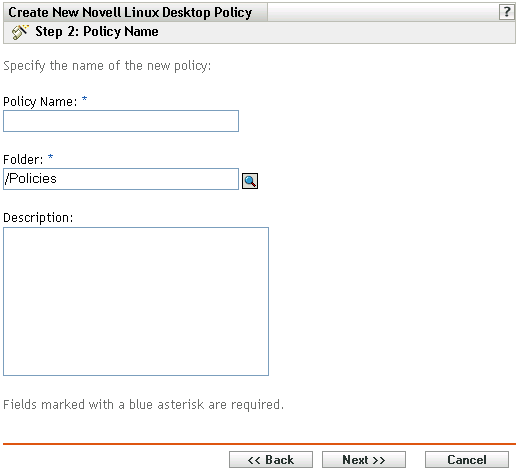
-
Fill in the fields:
-
Policy name: (Required) Provide a unique name for the policy. The name you provide displays in the ZENworks Control Center interface, which is the administrative tool for ZENworks Linux Management.
For more information, see Section C.0, Naming Conventions in the ZENworks Control Center.
-
Folder: (Required) Type the name or browse to the folder that this policy will be created in. Folders display in the ZENworks Control Center.
-
Description: Provide a short description of the policy. This description displays on the policy's Summary page in the ZENworks Control Center interface.
-
-
Click to display the Novell Linux Desktop Lockdown Settings page.
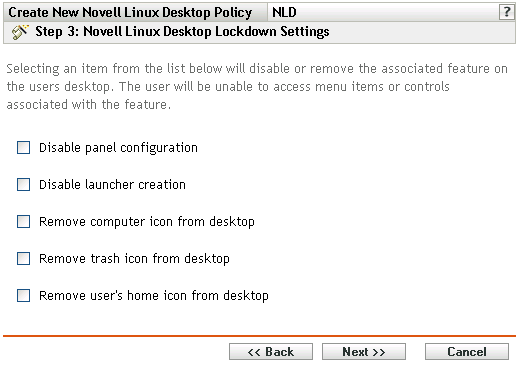
-
Select the desired options (by default, all options are disabled):
Selecting an item from the list disables or removes the associated feature on the user's desktop. The user cannot access menu items or controls associated with the feature.
Disable panel configuration: Lets you prevent users from configuring a panel. If you select this option, users cannot add and remove the icons on the panel.
Disable launcher creation: Lets you prevent users from creating application launchers.
Remove computer icon from desktop: Lets you remove the computer icon from users' desktops.
Remove trash icon from desktop: Lets you remove the trash icon from users' desktops.
Remove user's home icon from desktop: Lets you remove the Home icon from users' desktops.
-
Click to display the Novell Linux Desktop Menu Lockdown page.
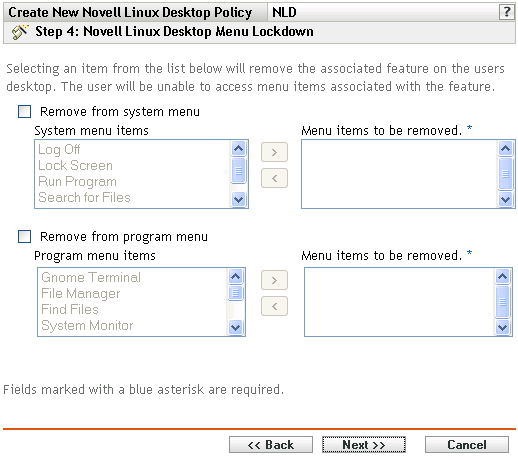
-
Select the items that you want to remove from desktops so that users cannot access menu items associated with the feature (by default, all options are disabled):
Remove from System menu: Lets you remove items from the menu of the Novell Linux Desktop. Select an item you want to remove and move it to the box on the right side. The item is removed from the users' menus.
Remove from Program Menu: Lets you remove items from the menu of the Novell Linux Desktop. Select an item you want to remove and move it to the box on the right side. The item is removed from the users' menus.
-
Click to display the Novell Linux Desktop Personal Settings and Applets Lockdown page.
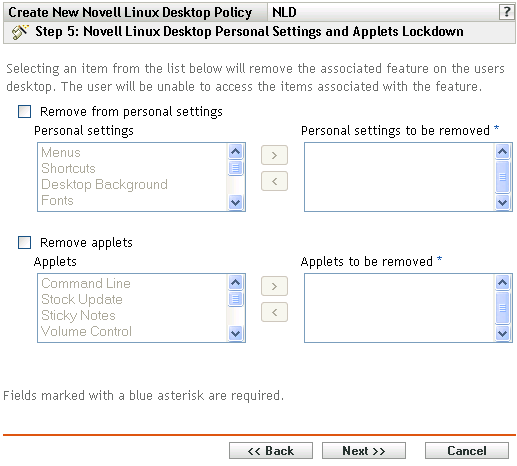
-
Select the items that you want to remove from desktops so that users cannot access menu items associated with the feature (by default, all options are disabled):
Remove from personal settings: Lets you remove items from the Personal Settings of Novell Linux Desktop. Select an item you want to remove and move it to the box on the right side. The item is removed from the users' Personal Settings.
Remove applets: Lets you prevent the applets from being displayed on users' Novell Linux Desktop. Select an applet from the list and move it to the box on the right side. Selected applets are not displayed on users' Novell Linux Desktop.
-
Click to display the Novell Linux Desktop Configuration Settings page.
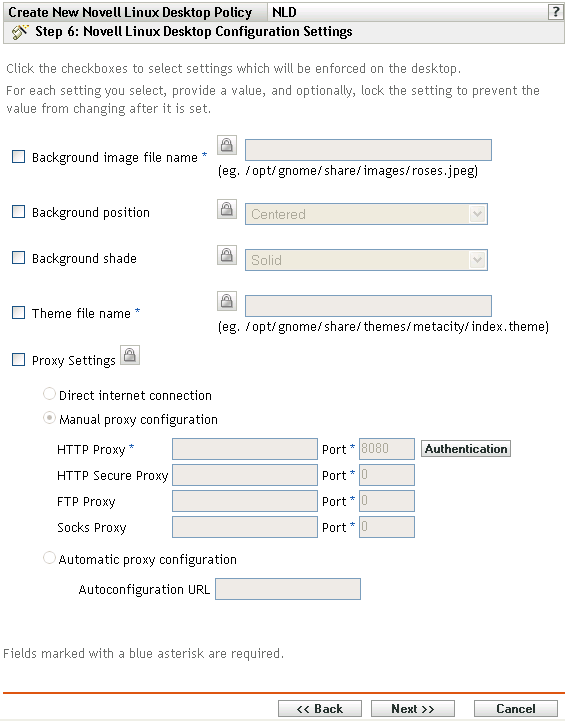
-
Select the desired options (by default, all options are disabled).
For each option you enable, provide a value. When you enable an option, it is locked by default. You can unlock the option by clicking
 . The options that are not enabled are excluded from the policy and are not applied to the device.
. The options that are not enabled are excluded from the policy and are not applied to the device.
Background image filename: Lets you specify the filename and complete location of a background image. This image file is displayed as a background on users' desktops. The file should exist on the managed device at the specified location.
Background position: Lets you specify background image display options. displays an image in the center of the screen, stretches the image to cover the entire screen, enlarges the image until the image meets the screen edges, and repeats the image over the screen. Select to prevent the image from being displayed on the desktop.
Background shade: Lets you choose an available shade to decorate the background. Select to have the background image uniform across the desktop. Select to have the image become darker as you go up, and select to have the image become darker as you go from left to right.
Theme filename: Lets you specify a theme file name and its complete location. The appearance of the windows, icons, buttons, and other graphical user interface controls are changed according to the selected theme.
Proxy settings: Specify a proxy setting:
-
Direct internet connection: Lets users connect to the Internet without using the proxy server.
-
Manual proxy configuration: Lets you manually configure the proxy. Specify the value, value, value, value, and corresponding port numbers.
To authenticate the user before proxy configuration, click Authentication. In the HTTP Proxy Authentication dialog box, select , specify the username and password, then click .
-
Automatic proxy configuration: Lets you automatically configure the proxy from a certain URL by specifying the URL.
-
-
Click to display the Default System Requirements for the Novell Linux Desktop Policy page.
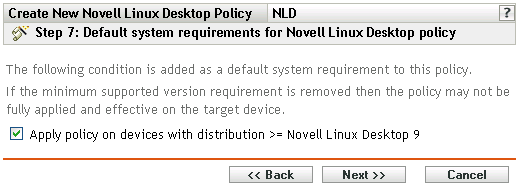
-
Specify the minimum version of Novell Linux Desktop required for all policy settings to be effective. Policy settings are applied only if a device has the same version or a newer version of the Novell Linux Desktop. If a device does not have Novell Linux Desktop 9 or newer, the policy does not apply correctly.
Even if you do not include this setting in the policy, the system checks for Novell Linux Desktop. If it does not find Novell Linux Desktop, an error message is generated and the policy is not applied.
NOTE:To ensure successful enforcement of all configured items, you need Novell Linux Desktop 9 with Support Pack 2 with GNOME.
-
Click to display the Summary page.
-
Click to create the policy as configured according to the settings on the Summary page. If you click , the Novell Linux Desktop policy is created but it does not have devices assigned or a schedule specified. At some point in the future, you need to configure additional options for the policy by continuing with Section 17.4, Assigning Policies.
or
Click to display the Policy Assignment page to perform the following tasks:
-
Specify assignments for this policy
-
Specify the schedule for this policy
-
Specify groups for this policy
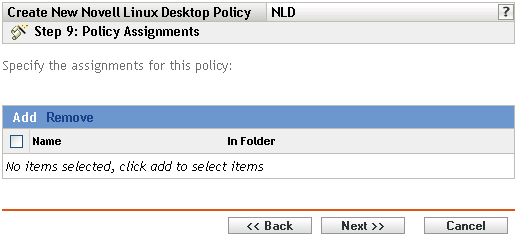
-
-
Assign the policy to the devices.
-
Click to browse for and select the appropriate Server or Workstation objects.
You can also select Folder or Group objects.
-
Click the down-arrow next to or to expand the list, then click the underlined link in the column to select the desired objects and display their names in the list box.
Assigning a policy to a Group object is the preferred method of assigning the policy. Assigning the policy to a large number of objects (for example, more than 250) might cause increased server utilization.
-
Click .
-
-
Click to display the Policy Schedule page.
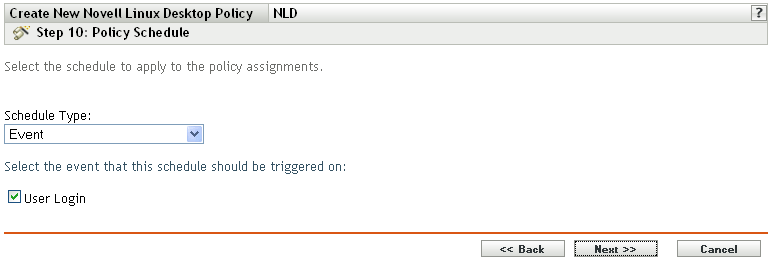
-
Select the schedule to apply to the assignments from the drop-down list, then select the desired options, which vary, depending on the schedule type you select.
The settings you configure on this page determine when the policy is applied to devices.
See Section 15.3, Schedules for information about the available schedules and their options.
-
Click to display the Policy Groups page.
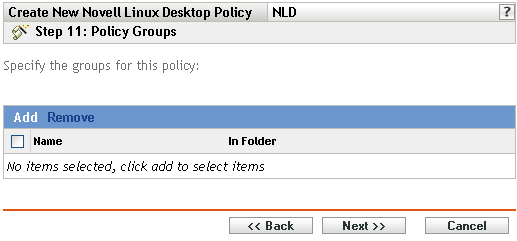
-
(Optional) Click to open the Select Groups dialog box, then click the underlined links in the column to select the desired policy groups and display their names in the list box.
Using policy groups eases administration efforts by letting you group several policies so you can use common assignments, schedules, and so forth, rather than configuring these settings for each policy you create. For more information, see Section 17.3, Creating Policy Groups.
-
Click to display the Finish page.
-
Review the information on the Finish page, making any changes to the policy settings by using the button as necessary. Click to create the policy as configured according to the settings on the Finish page.